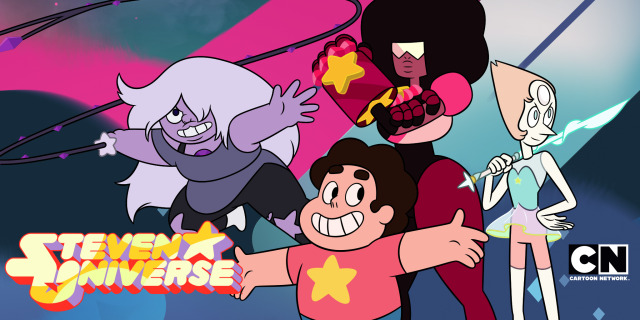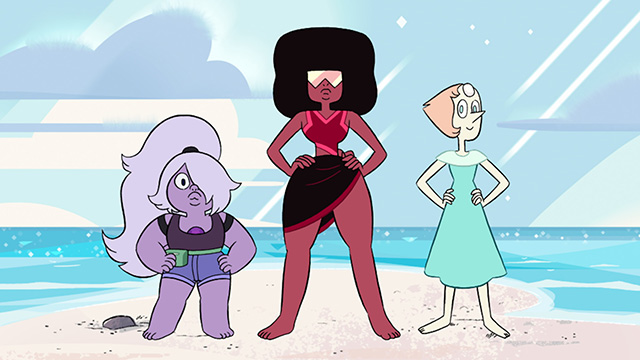Cartoon Network’s recent wave of original series, including Adventure Time and Regular Show, feels like a real sea change in American animation. These shows demonstrate a willingness to experiment, both in terms of animation style and bold storytelling choices. Debuting last year, Rebecca Sugar’s Steven Universe might be easily described as “Sailor Moon but with a chubby little boy.” One of the nice things about the show is that it never talks down or overexplains backstory: the Crystal Gems (magical immortal female guardians of humanity/Beach City that include worrywart Opal, gregarious Amethyst and quiet muscle Garnet) have taken Steven, the seemingly human son of one of their former members, Rose Quartz, under their wing at some unseen time in the past before the show’s pilot. The mystery of Steven’s missing mother, as well as his own developing powers, is a steadily unfolding underlying plotline throughout the series’ twenty-plus episodes to date. It’s funny, the animation (especially the background art) is gorgeous and each episode is pretty accessible to a new viewer. But where Steven Universe stands out the most is in its approach to its central concept and values.
Something that becomes apparent after you’ve seen a handful of Steven Universe episodes is, at least at this point, it has no villains. While, say, Adventure Time might get mileage out of bad guys like Ice King or The Lich, Steven Universe instead opts for interpersonal conflicts. An average episode revolves around Steven being expressly forbidden from doing something, only for him to do it anyway and unleash some kind of monster or threat. A great example of this is the episode “Cat Fingers”, in which Steven uses a newly developed but unpracticed shapeshifting ability to turn his fingers into actual cats that begin to horrifically overwhelm him in Cronenbergian fashion. Or “Frybo”, where Steven uses a magic crystal to bring a fast food mascot costume to life, which, naturally, turns into a gross monster.
Steven and the Gems don’t so much face bad guys as they do problems to be solved. In “Lars and the Cool Kids”, Steven and bully Lars have to save their friends from a feral living moss formerly tended to by Rose Quartz; the moss isn’t evil, it’s just trying to reach a mountain top so it can bloom into beautiful flowers. None of the “monsters” they fight possess more than a rudimentary, instinctual intelligence. The show seems to imply that the Crystal Gems’ job is enforcing the natural order of the universe and making sure things are in balance rather than fighting evildoers. (Interestingly, the only reference to “evil” the show makes is a brief mention from Steven in the show’s original pilot.)
What further distinguishes Steven Universe is how, in a largely male-centric cartoon landscape, it’s a distinctly feminine show. Although Steven is the main character, the women of Steven Universe, unlike many magical girl heroines, have non-traditional body types that inform their personalities. Pearl’s lithe dancer-like physique and tightly wound intellect clash with Amethyst’s curviness and natural charisma which in turn clash with the physically imposing, no-nonsense Garnet (whose design is a series of squares). Amethyst is especially interesting as her primary specialty is shapeshifting and she is, at all times, as comfortable in a new form (cat, ball, hairy male wrestler) as she is in her default body.
When viewed as a group, the Crystal Gems correspond to Freud’s concept of Id (Amethyst), Ego (Garnet) and Superego (Pearl) and, combined, they form the perfect parent for young Steven. While Steven’s well-meaning if foolish father Greg (voiced by venerable radio personality Tom Scharpling) is an active part of his life, the show makes it clear that the Gems are Steven’s primary guardians and surrogate family. While Greg very clearly loves his son, it’s obvious he can’t provide the kind of structure and discipline Steven’s life needs. You get the sense Greg Universe is the kind of sadsack Steven would grow up to be without the guiding hand of the Crystal Gems.
The takeaway here is that Steven’s role models on Steven Universe are almost entirely women; whether it’s Pearl teaching Steven swordfighting in “Steven The Swordfighter” or acting as Amethyst’s wrestling sidekick in “Tiger Millionaire”, it’s clear that most of his values come from the women in his life. Even Steven’s absent mother plays a huge, pivotal role in his development. In “Lars and the Cool Kids,” Steven snaps at Lars for calling his mom “weird.” It’s never explicitly spelled out, but Steven’s attempts to learn more about his mother and live up to her legacy makes up the emotional core of the series.
Where as many shows take time to find their footing, it feels like Steven Universe pretty immediately decided what kind of stories they wanted to tell. Namely, fun self-contained adventure stories with lots of humor, heart and a twinge of melancholy behind it (there’s a very Studio Ghibli-vibe to the end credits, a simple piano piece played over animation of laundry blowing on the breeze outside the Gems’ temple). More than that, though, Steven Universe is an exciting cartoon because it’s a “boy show” that quietly centers around/places a priority on the feminine. Allegorically, Steven, as the first human/Gem hybrid, is on a path toward becoming a powerful and wise hero. But more importantly, Steven Universe is concerned with a little boy learning the lessons that will make him a good man.
Steven Universe airs on Cartoon Network Thursdays at 6:30/5:30c.







People have been urging me to watch this show and this article only adds to my interest. Interesting how two of Cartoon Network’s flagship shows (SU and Adventure Time) feature male main characters with a host of female supporting characters and role models.